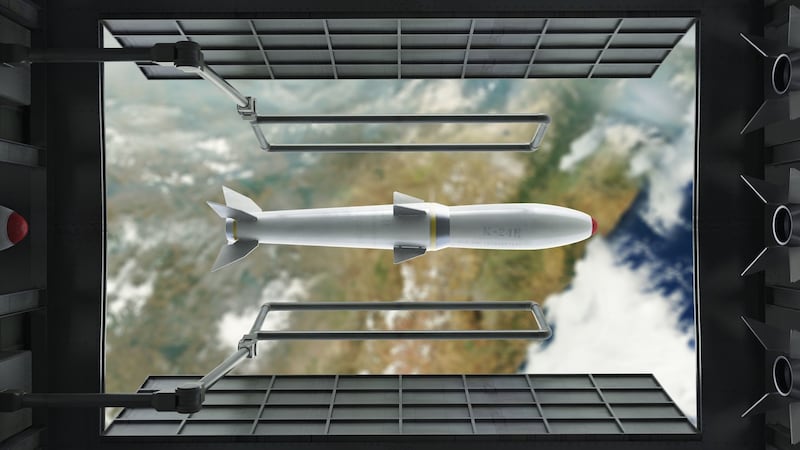To paraphrase Morrissey it was the bomb, the bomb that brought together the generations that lived through the Cold War. The prospect of nuclear war was regarded as a greater and more immediate threat to the human race than climate change is considered a threat in this decade.
The Cuban missile crisis of 1962 demonstrated that mankind was only a potential miscalculation away from annihilation. The chief protagonists, the Soviet Union and the United States, continued to stockpile more missiles than would be necessary for Armageddon – 70,000 in total, enough to kill everyone 700 times over.
The concept of mutually-assured destruction, first coined in the 1960s, led to the paradox that nuclear weapons have done more to keep the peace since the end of the second World War.
Just one nuclear weapon would be enough to trigger a global catastrophe
A succession of non-proliferation treaties, culminating in the New Strategic Arms Reduction Treaty (New Start) in 2010, which Russian president Vladimir Putin and then US president Barack Obama signed, led the world to believe that the threat of a nuclear war belonged to the past.
These treaties drastically reduced the number of nuclear weapons both sides had, though they retained enough to destroy the planet. According to the Federation of American Scientists (FAS), Russia had a stockpile of about 4,500 nuclear warheads in total. Of those, just under half are ready to be deployed.
The US has 3,600 warheads it could use. The numbers, though, are immaterial. Just one nuclear weapon would be enough to trigger a global catastrophe.
Russia's war in Ukraine has changed the calculus in a terrifying way. Military analysts are now openly speculating that a man unhinged enough to order the invasion of an advanced European democracy of 44 million people is equally capable of ordering the first nuclear strike since the atomic bomb was dropped on Nagasaki in 1945.
“I think no one can make any reliable or certain judgments as regards Vladimir Putin’s rationality. He has shown that he is willing to take immense risks. That should be enough to make us worry,” says Dr Ulrich Kühn, the head of arms control and emerging technologies at the Institute for Peace Research and Security Policy at the University of Hamburg.
High alert
Putin mentioned the n-word as early as February 27th, three days after the war started, when he put Russia’s nuclear forces on high alert.
Analysts have coined a phrase for many of Putin’s actions – “escalate to de-escalate”. Make threats, gather your forces, show that you are serious and then de-escalate the situation when the other side backs down. The Ukraine war has shown the limits of such an approach.
Earlier this month Lieut Gen Scott Berrier, the US’s highest-ranking military intelligence officer, gave a grim assessment of the threat posed by Putin as Russia continues to struggle in Ukraine.
“Russia will likely increasingly rely on its nuclear deterrent to signal the West and project strength to its internal and external audiences,” he wrote.
In such circumstances, Putin might be prepared to use “tactical, non-strategic nuclear weapons to compel an adversary [Ukraine]” to terms.
Strategic nuclear weapons are the intercontinental ballistic missiles (ICBM) designed to annihilate cities and likely to guarantee mutually-assured destruction. These missiles can carry a nuclear warhead capable of generating more than a megaton (a million tonnes) of TNT, 100 times the power of the Hiroshima bomb.
Tactical nuclear weapons are much smaller, some as small as a kiloton (1,000 tonnes of TNT), that can be dropped on an army or on larger military installations. Russia is capable of delivering these through its Iskander and Kalibr missile systems which are already in Ukraine. These are the weapons analysts believe Putin would most likely use if he decided to “go nuclear”.
Russia is estimated to have just over 1,900 of these assigned for delivery by air, naval, ground and various defensive services. Its so-called hypersonic missiles, which have been deployed in Ukraine, can also carry nuclear weapons. Hypersonic nuclear missiles could effectively be delivered without warning.
Chain of command
The chain of command in the US is clear. A US president can pre-emptively order a nuclear strike without consultation, though in practice he would be expected to consult with his secretary of defence at least.
In Russia it is not so clear. A study by the nuclear defence analyst Bruce Blair suggests Russia has inherited the system from the old Soviet Union whereby the president, the defence minister and the chief of the general staff all have separate codes which have to be integrated before a nuclear launch can happen, but this is speculation given the opaque nature of Putin’s regime and how he has consolidated power.
Both Dr Kühn and Dr Nick Ritchie, a lecturer in international security at the University of York, believe Putin does not have sole authority to launch a nuclear strike.
“The system appears to require the president plus the Russian defence minister [Sergei Shoigu] and the chief of the general staff [Valery Gerasimov],” says Dr Ritchie.
“The general staff would have to validate the authenticity of the order before transmitting it to relevant military units capable of firing those weapons authorised for release.”
Dr Ritchie believes Russia would only use nuclear weapons in the event of Nato entering the war directly and invading its borders.
“This would be an extreme response to what Moscow viewed as an extreme threat to the survival of the Russian state. Nuclear weapons serve no wider military purpose in the conflict. They are weapons of terror,” he says.
“Therefore I think a lot more would have to happen for Putin to consider using nuclear weapons, let alone authorise their actual use, but the possibility cannot be ruled out. That is the nature of crises involving nuclear-armed states.
“This would most likely involve the use of so-called ‘tactical’ weapons against Ukrainian and Nato forces. Nearly all of Russia’s tactical nuclear weapons are of a higher explosive yield than the bombs that annihilated Hiroshima and Nagasaki.”
Officially Russia’s nuclear policy, as outlined in a document published in 2020, is “exclusively one of deterrence” and is there to guarantee “protection of national sovereignty and territorial integrity of the state, and deterrence of a potential adversary from aggression against the Russian Federation and/or its allies.”
This would change in the event of attacks on Russian soil against its military infrastructure as well as “aggression against the Russian Federation with the use of conventional weapons when the very existence of the state is in jeopardy”.
Pavel Podvig, a Russia-born expert on his country's nuclear policy, said during the Cold War that the general secretary of the Communist Party could not act without consultation in ordering a nuclear strike, but Putin has consolidated power to himself.

Demonstration strike
Podvig also believes nuclear weapons serve no useful purpose and their use would only further damn Russia in the eyes of the world.
“The only mission that these weapons could carry out is either to kill a lot of civilians or it could be a demonstration strike. This is the only plausible explanation. Either way it is criminal.”
How would Nato respond in the event of a Russian nuclear strike?
US president Joe Biden has not ruled out responding in kind, but this could provoke a general escalation with disastrous consequences. Instead, Nato might make use of its clear advantages in conventional warfare to punish Russia.
Ireland would most likely be directly affected by a nuclear war if Russia was to target the UK
"Past US wargames have tried to simulate the possible crossing of the nuclear threshold by Russia in Europe, " says Dr Kühn.
“These war games have shown that the chances for all-out nuclear war would increase the more the US and Nato would reciprocate previous nuclear use by Moscow.”
Ireland would most likely be directly affected by a nuclear war if Russia was to target the UK. In 2019 the government published the National Plan for Nuclear and Radiological Emergency Exposures. Tellingly, it made no mention of nuclear weapons, predicting instead that the biggest nuclear threat to Ireland was from the Sellafield site. Dr Ritchie said the targeting of the UK might only happen in the event of an escalation of the conflict between Nato and Russia into a global nuclear conflict.
In such a scenario Dr Ritchie believes Russia could target the UK nuclear weapons complex, military and political command and control sites such as Menwith Hill and Fylingdales in north Yorkshire.
Were it to come to that, any mitigating factors taken in Ireland to limit the damage would most likely be futile, as he put it, “in the context of a ‘World War III’ scenario that has escalated out of all control and will result in a global catastrophe”.









